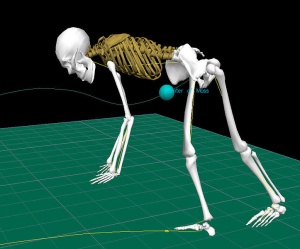Centre of Gravity
Original Editor - The Open Physio project.
Top Contributors - Admin, Sheik Abdul Khadir, Kapil Narale, Rachael Lowe, Kim Jackson, Laura Ritchie, Wanda van Niekerk, Lucinda hampton, Scott Buxton, Simisola Ajeyalemi, Jess Bell, Olajumoke Ogunleye, Tony Lowe, Evan Thomas, Tarina van der Stockt and WikiSysop
Introduction[edit | edit source]
Human center of gravity is a term that has implications for all things related to posture, including issues such as swayback, the design of posture exercise programs, and much more. Gravity is a downward pull or force that the earth exerts on your body. Your centre of gravity is the point where the mass of the body is concentrated. [1]
The centre of gravity (COG) of the human body is a hypothetical point around which the force of gravity appears to act. It is a point at which the combined mass of the body appears to be concentrated. [2] Because it is a hypothetical point, the COG does not have to lie within the physical boundaries of an object or person. One subjective way (there are objective measures) to approximate the COG of an object is to visualise it balancing on one finger.
Centre of Gravity in the Human Body[edit | edit source]
In the anatomical position, the COG lies approximately anterior to the second sacral vertebra. However, since human beings do not remain fixed in the anatomical position, the precise location of the COG is always shifting with each movement of the body and limbs. The proportion of body weight of the limbs, trunk, and head will also affect the location of the COG every time we move body positions. When something like a suitcase, grocery bag, or a backpack is carried, the CoG will change as weight is added to respective areas of the body. This point of CoG will change as the weight and position of a carried object changes, and is also based on the position and movement of the body. [1]
Stability and the Centre of Gravity[edit | edit source]
The direction of the force of gravity through the body is downward, towards the centre of the earth and through the COG. This line of gravity is important to understand and visualise when determining a person's ability to successfully maintain balance. When the line of gravity falls outside the Base of Support (BOS), then a postural reaction is needed in order to maintain balance.
When the line of gravity is within the BOS, an object or person is said to be stable. When the line of gravity falls outside the BOS, the object or person is said to be unstable. Given that the line of gravity must fall within the BOS in order to satisfy the criteria for stability, the following factors should be considered:
- A larger BOS increases stability (the line of gravity must move a greater distance to fall outside the BOS)
- A lower COG increases stability (it's unlikely that the line of gravity will fall outside the BOS)
Here are soem videos to help explain CoG
| [3] | [4] |
Centre of Gravity in Objects[edit | edit source]
Here is a video that explains and shows how to determine the COG in objects.
Clinical Implications[edit | edit source]
Examples of altered COG:
- Obese individuals have been shown to have a greater risk of falling (related to dynamic, rather than static components). This could be explained by the fact that an obese individual should not encounter a balance difficulty if their centre of gravity remains within their base of support. This is the case in a static situation. However, once the COG of an obese individual falls outside their base of support, maintaining balance may become more difficult than for an individual with normal weight, because of the increased body weight to be moved, and due to their relatively inferior mass specific lower limb power [6].
- Chronic Low Back Pain: A 2014 study published in the Journal of Back and Musculoskeletal Rehabilitation found that patients with chronic low back pain tend to have a center of gravity that is located predominantly towards the back. In the study, patients had decreased low back strength upon extension, plus a decreased amount of normal low back curve. The study authors concluded that individuals with chronic low back pain whose center of gravity is too far back might have strength and balance challenges to overcome in order to re-establish postural control. [1]
- Biomechanics in prosthetic rehabilitation
References[edit | edit source]
- ↑ 1.0 1.1 1.2 Verywellhealth. Complexity of Finding the Human Centre of Gravity. Available from:https://www.verywellhealth.com/human-center-of-gravity-296568 (accessed 14/04/2021).
- ↑ Hall SJ. Equilibrium and Human Movement. In: Hall SJ. eds. Basic Biomechanics, 8e New York, NY: McGraw-Hill; . http://accessphysiotherapy.mhmedical.com/content.aspx?bookid=2433§ionid=191511590. (Accessed June 12, 2019).
- ↑ muscle and Motion. Mastering Balance: The Science of Center of Gravity and Base of Support. Available from: https://www.youtube.com/watch?v=5s1gEi5wfLg&ab_channel=MuscleandMotion (accessed 20/04/2024)
- ↑ hplcchmc. Body Center of Mass Example - Motion Analysis. Available from: http://www.youtube.com/watch?v=HSW8gXmOazs [last accessed 09/03/13]
- ↑ vt.physics. Centre of Mass and Gravity CGSE Physics Required Practical. Available from: https://www.youtube.com/watch?v=vDqcEIdhJ_8&ab_channel=vt.physics (accessed 20/04/2024).
- ↑ Pataky Z, Armand S, Müller‐Pinget S, Golay A, Allet L. Effects of obesity on functional capacity. Obesity. 2014:22(1):56-62.







